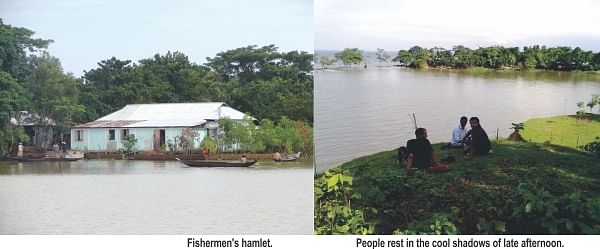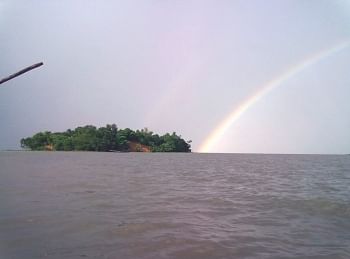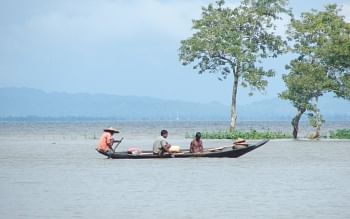| Home - Back Issues - The Team - Contact Us |
 |
| Volume 10 |Issue 37 | September 30, 2011 | |
|
|
Environment
Charm of the Haor of Hakaluki BODRUZZAMAN SAKIB It was raining heavily when I safely reached a tilla (hillock), standing at a sharp angle on the bank of Hakaluki and I saw a child, who would probably be eight or nine years of age, carrying an umbrella in his hand. His intention was perhaps to help me in the torrential downpour or perhaps it was more than that, and the boy had certainly performed his duty better than I had expected. Just like the previous year, we made our second trip to the area in the month of July on an invitation from a friend, who lives in Ghilachara. While moving towards Ghilachara, an area near the Hakaluki Haor in Fenchugonj, Sylhet, I started to watch in amazement the greeneries of the roadside villages, of the small hills and the row of tillas and the fields with seasonal paddy on which the unceasing raindrops were painting an additional shape of stunning beauty.
After having lunch in the late afternoon, I made up my mind to take rest for a while. The raindrops were still sprinkling on the ground. The day-night interlude was yet to come. But the darkness of the evenfall seemed about to diffuse over the entire locality and the tranquil water of the haor. A good number of local children were swimming at the edge of the haor, ignoring any sorts of danger which made me more curious about the vast water body, and I could not but join the children in their joy.
The Hakaluki haor, the largest haor in the country with its vast water body, engulfs huge areas during the rainy season including Fenchugonj and Golapgonj upazila of Sylhet district and Borolekha, Kulaura and Juri of Moulvibazar. It is inundated with monsoon rain and by the water flow from the 'Assam's hills. No severe tide or no harsh wave is in the Hakaluki; but during the rainy season the haor becomes dangerous for the inhabitants of the region. A good number of tillas and a vast quarter of paddy fields near the haor go under water every year and cause difficulties for the local farmers. Besides, the gradual erosions of tillas over the years becomes a continuous process during the season. Abdul Wahab, a businessman who lived in Fenchugonj, was peeved with the situation. He had a plan to build something like a tourist centre on the top of a tilla at Ghilachara. Sadly the devouring water body washed away his hopes even before he has planned to bring it to light. The rainy season, otherwise, appears as a sign of blessing every year to the people in small segments of the region who are largely dependent on fishing for their livelihood. A vast water body stretches as far as the eye can see to the south-eastern side of the haor. A range of hills under the upazila of Borolekha and Juri get submerged up to the throat. A range of hills of Assam can be seen in the distant. In the morning of the following day, sitting on a tilla, I tried to observe what was going on in the hamlet of some fishermen on the surface of water. The repeatedly uttered common sylheti word kita' was only understood. Nonetheless, with my friend's help, I tried to find out what was going on: 'Kitaba machh kila fairay…?' and many more such words broke the silence of the early morning.
A boat was hired and a boatman named Koton majhee was supposed to aid us in boating and swimming. A sudden gust of wind blew over the haor when we were swimming. We were almost thrown in a horrible situation as our small boat was about to capsise, and panic gripped us. But the majhee was very confident in the helm. He asked us not to worry. Our surroundings, we observed, got busier. Water vehicles like 'Bojra,' a big boat mainly for carrying passengers, fishing boats, and also a good number of 'paal tola nouka' were darting to and fro. While we were on the way to the bank, it began to drizzle as there were small pieces of clouds still floating in the sky. A combination of several colours glittered in the eastern sky, seemed to be dancing nicely on the haor water. We were charmed by the unravished beauty of the haor. A magnificent place to be in.
Photos: Tanvir Hossain
Copyright
(R) thedailystar.net 2011 |



